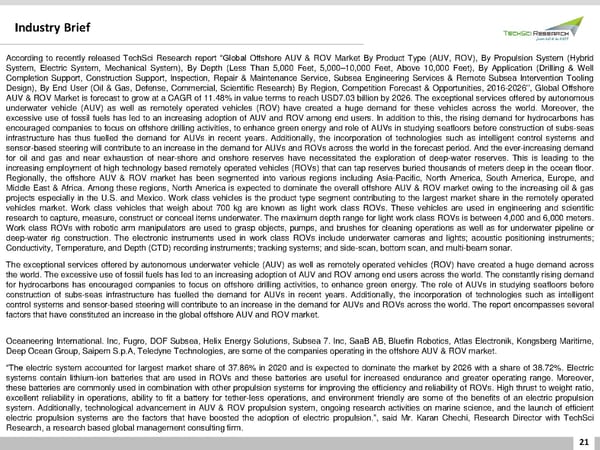Industry Brief According to recently released TechSci Research report “Global Offshore AUV & ROV Market By Product Type (AUV, ROV), By Propulsion System (Hybrid System, Electric System, Mechanical System), By Depth (Less Than 5,000 Feet, 5,000–10,000 Feet, Above 10,000 Feet), By Application (Drilling & Well Completion Support, Construction Support, Inspection, Repair & Maintenance Service, Subsea Engineering Services & Remote Subsea Intervention Tooling Design), By End User (Oil & Gas, Defense, Commercial, Scientific Research) By Region, Competition Forecast & Opportunities, 2016-2026’’, Global Offshore AUV&ROVMarketisforecasttogrowataCAGRof11.48%invaluetermstoreachUSD7.03billionby2026.Theexceptional services offered byautonomous underwater vehicle (AUV) as well as remotely operated vehicles (ROV) have created a huge demand for these vehicles across the world. Moreover, the excessive use of fossil fuels has led to an increasing adoption of AUV and ROV among end users. In addition to this, the rising demand for hydrocarbons has encouraged companies to focus on offshore drilling activities, to enhance green energy and role of AUVs in studying seafloors before construction of subs-seas infrastructure has thus fuelled the demand for AUVs in recent years. Additionally, the incorporation of technologies such as intelligent control systems and sensor-based steering will contribute to an increase in the demand for AUVs and ROVs across the world in the forecast period. And the ever-increasing demand for oil and gas and near exhaustion of near-shore and onshore reserves have necessitated the exploration of deep-water reserves. This is leading to the increasing employment of high technology based remotely operated vehicles (ROVs) that can tap reserves buried thousands of meters deep in the ocean floor. Regionally, the offshore AUV & ROV market has been segmented into various regions including Asia-Pacific, North America, South America, Europe, and Middle East & Africa. Among these regions, North America is expected to dominate the overall offshore AUV & ROV market owing to the increasing oil & gas projects especially in the U.S. and Mexico. Work class vehicles is the product type segment contributing to the largest market share in the remotely operated vehicles market. Work class vehicles that weigh about 700 kg are known as light work class ROVs. These vehicles are used in engineering and scientific research to capture, measure, construct or conceal items underwater. The maximum depth range for light work class ROVs is between 4,000 and 6,000 meters. Work class ROVs with robotic arm manipulators are used to grasp objects, pumps, and brushes for cleaning operations as well as for underwater pipeline or deep-water rig construction. The electronic instruments used in work class ROVs include underwater cameras and lights; acoustic positioning instruments; Conductivity, Temperature,and Depth (CTD) recording instruments; tracking systems; and side-scan, bottom scan, and multi-beam sonar. The exceptional services offered by autonomous underwater vehicle (AUV) as well as remotely operated vehicles (ROV) have created a huge demand across the world. The excessive use of fossil fuels has led to an increasing adoption of AUV and ROV among end users across the world. The constantly rising demand for hydrocarbons has encouraged companies to focus on offshore drilling activities, to enhance green energy. The role of AUVs in studying seafloors before construction of subs-seas infrastructure has fuelled the demand for AUVs in recent years. Additionally, the incorporation of technologies such as intelligent control systems and sensor-based steering will contribute to an increase in the demand for AUVs and ROVs across the world. The report encompasses several factors that have constituted an increase in the global offshore AUV and ROV market. Oceaneering International. Inc, Fugro, DOF Subsea, Helix Energy Solutions, Subsea 7. Inc, SaaB AB, Bluefin Robotics, Atlas Electronik, Kongsberg Maritime, DeepOceanGroup,SaipemS.p.A,Teledyne Technologies, aresomeof the companiesoperatingin the offshoreAUV & ROV market. “The electric system accounted for largest market share of 37.86% in 2020 and is expected to dominate the market by 2026 with a share of 38.72%. Electric systems contain lithium-ion batteries that are used in ROVs and these batteries are useful for increased endurance and greater operating range. Moreover, these batteries are commonly used in combination with other propulsion systems for improving the efficiency and reliability of ROVs. High thrust to weight ratio, excellent reliability in operations, ability to fit a battery for tether-less operations, and environment friendly are some of the benefits of an electric propulsion system. Additionally, technological advancement in AUV & ROV propulsion system, ongoing research activities on marine science, and the launch of efficient electric propulsion systems are the factors that have boosted the adoption of electric propulsion.”, said Mr. Karan Chechi, Research Director with TechSci Research, a research based global managementconsulting firm. 21
 GLOBAL OFFSHORE AUV & ROV MARKET 2026 Page 20 Page 22
GLOBAL OFFSHORE AUV & ROV MARKET 2026 Page 20 Page 22